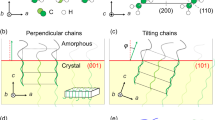Summary
In this report, the relaxation behavior of amorphous poly(ethylene terephthalate) (PET) in global chain orientation but nearly random segmental orientation (GOLR) state is studied by infrared dichroism, optical birefringence and hot shrinkage measurements at temperatures below or up PET's glass transition temperature, Tg. The results indicate that the difference in the relaxing rate between global chains and segments is at least in ∼ 102 times order above PET's Tg (∼ 84°C), with a rough approximation; while the sudden decrease of small Δn of the sample (∼ 10−4) upon being treated at about 85 ∼ 90°C, implies us that the small Δn is closely related with the orientation of global chains.
Similar content being viewed by others
Author information
Authors and Affiliations
Additional information
Received: 22 January 1998/Revised version: 28 March 1998/Accepted: 13 April 1998
Rights and permissions
About this article
Cite this article
Song, R., Lin, X., Gao, J. et al. The relaxation behavior of amorphous PET in global chain orientation but nearly random segmental orientation (GOLR) state. Polymer Bulletin 40, 773–778 (1998). https://doi.org/10.1007/s002890050321
Issue Date:
DOI: https://doi.org/10.1007/s002890050321




